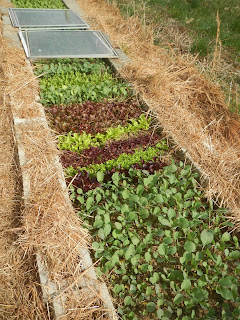Seeds are started in open plastic flats filled with our composted cow manure/sawdust near a south facing window (but not altogether even in the light of that window) in an upstairs room that gets warmer than the rest of the house.
Once the seeds germinate, they are moved out to our freezer cold frames for sunlight. There is a wooden frame in each freezer that the flats rest on, bringing them closer to the top. Below the flats are square 4 gallon buckets filled with water to provide extra thermal mass for buffering nighttime temperature swings.
While the freezer cold frames work really well to keep the seedlings warm during the day and comfortable at night when they're closed, we've learned a few things over the years. First, we need to be around to adjust as needed. If the sun suddenly pokes through on an otherwise overcast day, the glass needs to be moved to give some ventilation or the temperature can quickly rise too high. Since the plants are sitting so close to the glass, there's not much temperature buffer once it gets sunny. On windy days, it can be a bit tricky to balance enough ventilation without the plants getting too much air movement.
Unlike the first freezer in the picture above, we think it's best to saw through the freezer hinges and completely remove the lid. Otherwise, the underside of the lid, which is plastic, will degrade in the sun and fall apart prematurely.
After the plants in flats get big enough, we transplant the cold tolerant ones (like lettuce, cabbage, chard, etc.) into our nursery bed. This is simply a temporary -- we move our nursery bed around from year to year -- cinder block raised bed in the garden. Storm windows are taken on and off to provide extra heat as needed. And on really cold nights, the beds are also covered with blankets. We also direct seed the same crops into the nursery beds for a later succession of plants.

For less cold tolerant transplants, like tomatoes, peppers, eggplant, and a miscellaneous overflow of other plants in flats and pots, we have a cold frame on the south side of our house. On the coldest nights, we cover the glass with blankets.
We're no experts on this and are still figuring things out, but this is an evolving system that we're using 17 years into our very small-scale but full-time farm. It's a very low-cost, low energy system built largely around reused materials (storm windows, broken freezers, cinder blocks...) that we've mostly gotten through free stuff ads on the internet.







No comments:
Post a Comment